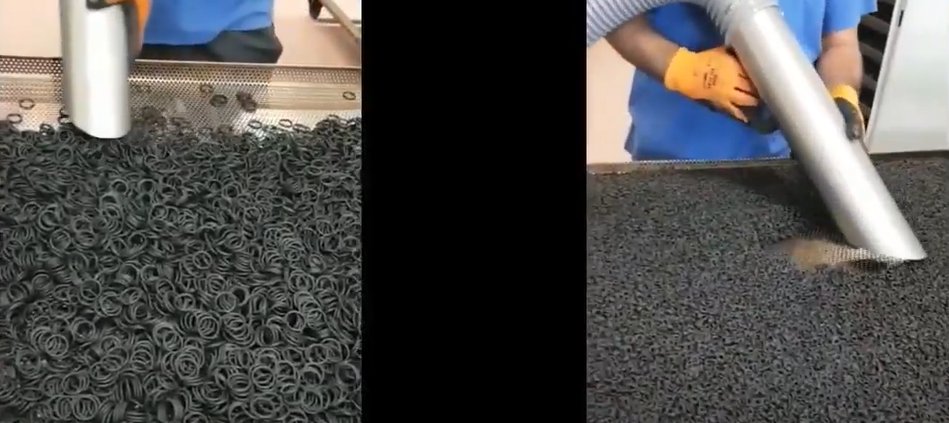O-ring pneumatic conveyin system
In this video we show a very simple pneumatic conveying system for handling elastomer rings: before this solution, handling was done manually by an operator.
The negative consequences of this operation were that some of these parts fell off, causing damage and obliging to discard them, leading to a loss in economic terms.
The other negative aspect was that the manual procedure was much more time-consuming than the automated one and required much more human physical effort.
Technical data of the application:
- Side channel blower: 1200 mc/h; -250 mbar depression; power 12.5 Kw
- Excluding-valves group
- Safety filter in suction
- Hopper: Ø 560 mm; thickness 3 mm; material Stainless steel
- Lance made of steel with internal teflon coating, externally made of AISI 304 stainless steel
- Discharge chamber with automatic pistons
- Customised discharge cone
Pneumatic transport for O-rings
Tecnogomma International was founded in 1976 as a manufacturer of elastomer rings, with a circular cross-section, the so-called O-rings, normally used as mechanical seals or gaskets. Over the years the company has become a world leader supplying technical rubber to the automotive, oil & gas, drinking water and household appliance markets.
The compound, the rubber processing and the quality of the O-rings made it a unique product, which competitors have been trying unsuccessfully to replicate for years. The dimensions must be almost perfect because of the positions where they have to be placed, and the rubber characteristics must be maintained over time, especially when in contact with aggressive liquids and substances such as mineral oil or benzene.
The Tecnogomma OR rubbers range from 2 mm to 100 mm in diameter, with each customer having its own diameter, geometry and dedicated compound. At the end of production the batches are placed on perforated multi-shelf tables and from there manually transferred to the appropriate container. There are several disadvantages of this way of working: it is time-consuming and there is always the risk that some O-rings will fall into another customer’s tray and remain there, because they are not easy to distinguish by sight. Mistakes like this must be avoided at all costs, as the risk of compromising the finished product is very high.
What we were asked to do
Apply was called to perfect these product selection and storage phases, with the aim of speeding them up, freeing up workers to move to other production tasks and absolutely not mixing products with different characteristics. The first two requirements can be met with a pneumatic conveying system suitably sized for O-rings, while the third required a special study.
To make sure that there is no contamination between different O-rings, it is necessary that absolutely all of the sucked product reaches its destination throught the pneumatic conveying system. No ring must lag or get stuck in any section of the suction cycle, otherwise it may be aggregated to the next batch.




